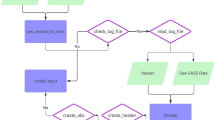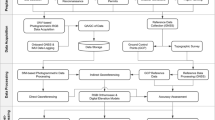Abstract
This paper describes an Ajax (Asynchronous JavaScript and XML) GIS (geographic information system) application for the simulation of GNSS (Global Navigation Satellite System) availability in dense urban areas. In the forthcoming GNSS environment, satellite visibility will be greatly increased owing to the integration of multiple GNSSs such as the American GPS (Global Positioning System), the Russian GLONASS (Global Navigation Satellite System), the European Union’s GALILEO, and the Japanese QZSS (Quasi-Zenith Satellite System). However, in dense urban areas, the improvements of position accuracy may be limited because obstruction of the signal by high buildings results in bad geometries and multipath effects. To evaluate the spatiotemporally varying availability of GNSS positioning, we built an estimation model that computes the number of visible satellites, the values of DOP (dilution of position), and the amount of multipath errors, according to the location and time of a user. Then, the GNSS availability components were visualized in an Ajax-based Web application that provides a desktop-like interactiveness through the asynchronous data transfer between client and server. This Web simulation shows when and where the navigation services by integrated GNSS are available or appropriate in urban canyons. As a feasibility test, we demonstrated an experimental simulation for the Shinjuku ward of Tokyo filled with skyscrapers.
Similar content being viewed by others
References
Dellago, R., Detoma, E., and Luongo, F. (2003). “Galileo-GPS interoperability and compatibility: a synergetic viewpoint.” Proceedings of Institute of Navigation Global Positioning System/Global Navigation Satellite System (ION GPS/GNSS) 2003, pp. 542–548.
Feng, Y. and Wang, J. (2007). “Exploring GNSS RTK performance benefits with GPS and virtual Galileo measurements.” Proceedings of Institute of Navigation National Technical Meeting (ION NTM) 2007, pp. 218–226.
Garrett, J.J. (2005). “Ajax: a new approach to Web applications.” http://www.adaptivepath.com/ideas/essays/archives/000385.php.
Januszewski, J. (2007). “Visibility and geometry of combined constellations GPS and Galileo.” Proceedings of Institute of Navigation National Technical Meeting (ION NTM) 2007, pp. 252–262.
Kaplan, E.D., Leva, J.L., Milbert, D., and Pavloff, M.S. (2006). “Fundamentals of satellite navigation.” In: Kaplan, E.D. and Hegarty, C.J. (Ed.) Understanding GPS: Principle and Applications. Artech House, Norwood, MA, pp. 21–65.
Kawano, I., Mokuno, M., Kogure, S., and M. Kishimoto. (2004). “Japanese experimental GPS augmentation using Quasi-Zenith Satellite System.” Proceedings of Institute of Navigation Global Navigation Satellite System (ION GNSS) 2004, pp. 175–181.
Kogure, S., Kishimoto, M., and Sawabe, M., and Sawabe, M., (2007). “Future expansion from QZSS to regional satellite navigation system.” Proceedings of Institute of Navigation National Technical Meeting (ION NTM) 2007, pp. 455–460.
Lavrakas, J.W. (2007). “A glimpse into the future: a look at GNSS in the year 2017.” Proceedings of Institute of Navigation National Technical Meeting (ION NTM) 2007, pp. 210–217.
Li, J., Taylor, G., Kidner, D., and Ware, M. (2006). “Prediction of GPS multipath effect using LiDAR digital surface models and building footprints.” Lecture Notes in Computer Science, Vol. 4295, pp. 42–53.
Paulson, L.D. (2005). “Building rich Web applications with Ajax.” IEEE Computer, Vol. 38, No. 10, pp. 14–17.
Seynat, C., Kealy, A., and Zhang, K. (2004). “A performance analysis of future Global Navigation Satellite Systems.” Journal of Global Positioning Systems, Vol. 3, No. 1–2, pp. 232–241.
Suh, Y. and Shibasaki, R. (2007). “Evaluation of satellite-based navigation services in complex urban environments using a three-dimensional GIS.” The Institute of Electronics, Information and Communication Engineers (IEICE) Transactions on Communications, Vol. E90-B(7), pp. 1816–1825.
Taylor, G., Li, J., Kidner, D., Brunsdon, C., and Ware, M. (2007). “Modelling and prediction of GPS availability with digital photogrammetry and LiDAR.” International Journal of Geographic Information Science, Vol. 21, No. 1, pp. 1–20.
Townsend, B., Wiebe, J., and Jakab, A. (2000). “Results and analysis of using the MEDLL receiver as a multipath meter.” Proceedings of Institute of Navigation National Technical Meeting (ION NTM) 2000, pp. 73–79.
Van Nee, R.D.J., Siereveld, J., Fenton, P.C., and Townsend, B.R. (1994). “The multipath estimating delay lock loop: approaching theoretical accuracy limits.” Proceedings of IEEE Position Location and Navigation Symposium (PLANS) ’94, pp. 246–251.
Ward, P.W., Betz, J.W., and Hegarty, C.J. (2006). “Interface, multipath, and scintillation.” In: Kaplan, E.D. and Hegarty, C.J. (Ed.) Understanding GPS: Principle and Applications. Artech House, Norwood, MA, pp. 243–299.
Wu, F., Kubo, N., and Yasuda, A. (2004). “Performance analysis of GPS augmentation using Japanese Quasi-Zenith Satellite System.” Earth, Planets and Space, Vol. 56, No. 1, pp. 25–37.
Zimmermann, F., Haak, T., Steindl, E., Vardarajulu, S., Kalden, O., Hill, C. (2005). “Generating Galileo raw data — approach and application.” Proceedings of Data Systems in Aerospace (DASIA) 2005, CD-ROM.
Author information
Authors and Affiliations
Corresponding author
Rights and permissions
About this article
Cite this article
Lee, YW., Suh, Y. & Shibasaki, R. Ajax GIS application for GNSS availability simulation. KSCE J Civ Eng 11, 303–310 (2007). https://doi.org/10.1007/BF02885901
Received:
Accepted:
Issue Date:
DOI: https://doi.org/10.1007/BF02885901




